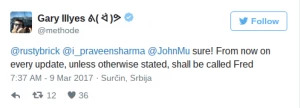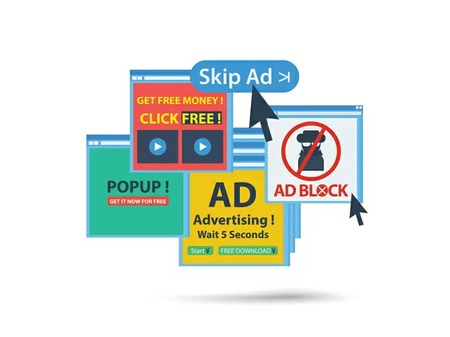Google makes hundreds of adjustments to the algorithm every year. There is a possibility that this was not an original update as much as it was a ‘turning up’ of signals that already existed in an effort to improve the user experience online.
Some updates made a big enough splash to be named by Google or the community, but Google now discourages thinking of them as discrete or separate things. They would prefer to focus on the quality, relevance, user experience, and site performance. But when asked, Gary Illyes of Google conceded we could just call it and other updates Fred, which is to say we should not call it anything, so I will only refer to it that way twice more in this post.
Beginning on March 8, 2017, the industry began to recognize signs of another update from Google. As the Google Fred update finished rolling out, it impacted a narrow number of sites significantly with some reporting traffic drops of as much as 50 to 90 percent. Although this update remains unconfirmed by Google, Gary Illyes suggested that it, and all updates-- unless otherwise stated-- should be named ‘Fred' during a twitter exchange with some SEO leaders, and the name has stuck.

Here is what you need to know about the Google Fred update and its impact on SEO and search.
What did the Google Fred update target? Probably excessive ads, thin content, and poor quality links as usual, right?
Since Google has not officially released anything regarding the Google Fred update, SEO professionals have had to try to identify the likely causes of the ranking changes based on observation. SEOs generally agree that the most significant focus appears to be content quality and ads.
"After reviewing well over 70 sites that were hit by the Google Fred update, 95% of them share two things in common. The sites all seem content driven, either blog formats or other content-like sites, and they all are pretty heavy on their ad placement. In fact, if I dare say, it looks like many (not all but many) of them were created with the sole purpose of generating AdSense or other ad income without necessarily benefiting the user."
In other words, Barry believes that the Google Fred update went after sites more focused on generating immediate revenue for the site, such as through ads and affiliate links, than providing real content value for the end user. They were often filled with content, but the material might cover a wide range of topics and often the content did not add much more value than what was already posted on countless other sites. The content published on the site instead revolved around promoting revenue building opportunities for the site.
There has also been conversation around the link profiles of the sites that saw the largest penalties. Some believe that the Google Fred update prioritized lowering the rankings of sites that had numerous links from poor quality pages. Google has not done much to acknowledge the update; they have said as they usually do that they are continually updating. There is a possibility that this was not an original update as much as it was a ‘turning up’ of signals that already existed in an effort to improve the user experience online.
The BrightEdge community is made up of 1,500+ of the most known and reputable brands in the world, so none reported any impact from the Google Fred update. Our community is full of serious SEOs using white hat techniques. The era of the black hat is finished. That is the beauty of using a philosophy, workflow, and platform centered around quality, relevant content, positive user experience, and proper site architecture and performance-- the BrightEdge community is nearly immune from algorithm updates and penalties.
What should I do if I was hit by the Google Fred update?
If your traffic and rankings drop off after the roll out of an update, look closely at your website. See how closely you align to the pattern of sites that received the biggest penalties. If your site promotes advertisements, consider removing them. Similarly, review your link profile. Look for any spam-y or other low quality sites that have linked to your page. Use the disavow tool and file to let Google know that you do not want to associate your site with that page.
S ince Google has told us so little about the Google Fred update, we do not really have a strong timeline on how long it would take your site to recover from this penalty, even after you have taken the right steps. We encourage you to correct any problems right away, however, to ensure that your site is ready to recover any lost rankings and traffic as soon as possible. Proper SEO should usually start to show results within a few weeks.
ince Google has told us so little about the Google Fred update, we do not really have a strong timeline on how long it would take your site to recover from this penalty, even after you have taken the right steps. We encourage you to correct any problems right away, however, to ensure that your site is ready to recover any lost rankings and traffic as soon as possible. Proper SEO should usually start to show results within a few weeks.
Remember as you develop content in the future that the primary priority needs to be on the needs of the user. Creating material for a website is not about writing content that you appreciate or that helps you generate traffic or ad revenue, it is about meeting the needs of the customers and helping them find the information and insights they need. Select topics where your expertise will be appreciated by your audience and produce content that offers them a unique perspective.
Although links can offer some value for your website, artificially building links can create major challenges for you. Past Google penalties have targeted sites with suspect link profiles, and discussion surrounds the role of the Google Fred update in further demoting the rankings of these pages. Optimal link building grows organically and only through reputable websites.
Asking other well-regarded sites that mention your brand or research to link back to your site is fine, paying for any type of link or engaging in reciprocal linking schemes-- where you and another site link back and forth to each other-- potentially sets you up for considerable losses. Fortunately, when you produce high-quality content and promote that content on social media, email, and your website, you build yourself a strong base to naturally encourage links.
How can BrightEdge help brands with the Google Fred update or any update penalty?
At BrightEdge, our platform design helps customers move confidently throughout the SEO field and navigate their brands to success. We recommend regularly tracking all your pages so that you can see any potential changes in page rankings as well as your Data Cube Score. These changes will all provide you with immediate clues about benefiting from, or being penalized by, an update.
Through keyword tracking, you can then dig further to see which keywords have lost or gained positions. Then through the Data Cube, you can see how your competitors have weathered the changes.
We also recommend that you use the BrightEdge backlinks function to watch your link profile. If you see suspicious or spam-y sites pop up, do not be afraid to use the Google Disavow tool to let the search engine giant know that you do not want your site associated with that link. Our backlink profiling function will also provide you with constructive ideas to build authentic links to your pages.
ContentIQ lets you adjust your crawl settings to comply with your organization’s digital standards, including content governance, web accessibility standards, and website architecture. You can isolate your crawl to focus on just a few pages or to complete a full audit of your entire website.
And since ContentIQ is available within the BrightEdge SEO platform, you maximize efficiency by identifying, fixing, and monitoring site errors within a single workflow. This means that you can use BrightEdge platform features in conjunction with your ContentIQ site audit data. For example, use StoryBuilder to build engaging dashboards and charts that demonstrate the impact of recent site revisions.
Finally, the Data Cube provides multiple tools for learning about the topics that your customers want to read. You can use the Data Cube to look at keyword phrases, traffic, and competition levels. Use the same feature to dive into competitor sites to see what they rank for that you do not.
You can also monitor trends in the industry and uncover new topic ideas just as they become popular with your audience. Use these genuine content-idea generating features so that you can confidently produce content that your audience wants to read. Then, take the topics deeper so that the material provides immediate value for the reader.


